Locomotive characteristics
See also: Multiple Unit characteristics .
Information on BR and Successors Locomotive Types
| Loco Type | Power | Max Speed | Accel/Trains Worked | Notes | Picture | |
|---|---|---|---|---|---|---|
| Shunters Class 01 | Diesel | 14.25 mph | Medium | Andrew Barclay; Various allocations; 2 used at Holyhead Breakwater for a number of years until the system closed in 1980 | https://en.wikipedia.org/wiki/British_Rail_Class_01 | |
| Shunters Class 02 | Diesel | 19.5 mph | Medium | Yorkshire Engine Company; Allocation on MR; 7 preserved | https://en.wikipedia.org/wiki/British_Rail_Class_02 | |
| Shunters Class 03 | Diesel | 28.5 mph | Medium | BR Swindon and Doncaster Works; Various allocations; Many preserved | https://en.wikipedia.org/wiki/British_Rail_Class_03 | |
| Shunters Class 04 | Diesel | 27 mph | Medium | Drewry, Vulcan Foundry and Robert Stephenson & Hawthorne; Various allocations | https://en.wikipedia.org/wiki/British_Rail_Class_04 | |
| Shunters Class 05 | Diesel | 18 mph | Medium | Hunslet; MR & ScR; One also used on the Isle of Wight system for a few years | https://en.wikipedia.org/wiki/British_Rail_Class_05 | |
| Shunters Class 06 | Diesel | 22.8 mph | Medium | Andrew Barclay; All allocated in Scotland | https://en.wikipedia.org/wiki/British_Rail_Class_06 | |
| Shunters Class 07 | Diesel | 27.5 mph | Medium | Ruston & Hornsby; Used in Southampton Docks (Replaced the USA Tanks); 7 preserved | 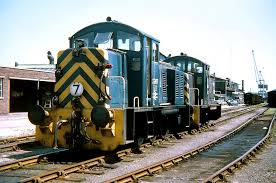 |
|
| Shunters Class 08 | Diesel | 15/20 mph | Very High | BR Crewe, Darlington, Derby, Doncaster and Horwich Works; Ubiquitous to all regions; The once huge fleet of over 1000 loco's is now significantly reduced with most TOCs owning small numbers for stock movement within depots; DBS have now sold their remaining 40 loco's; Over 60 preserved; EE Engine and equipment | 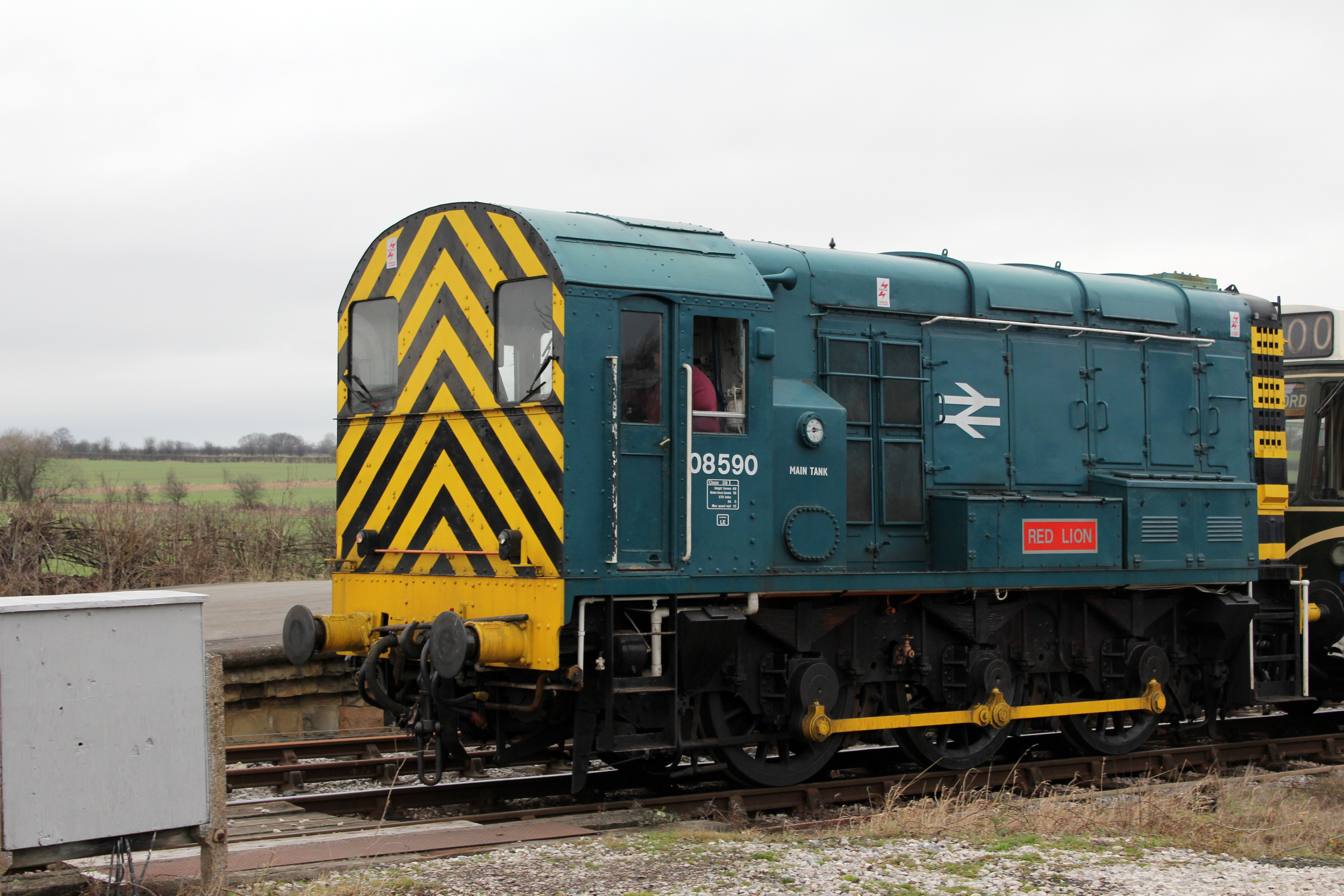 |
|
| Shunters Class 09 | Diesel | 25 mph | Very High | BR Darlington and Horwich Works; Mainly SR but some Class 08's converted to 09 in 1992 (09/1 and 09/2) to work in specific locations; 11 of the original Class 09/0 SR loco's preserved; EE Engine and equipment | 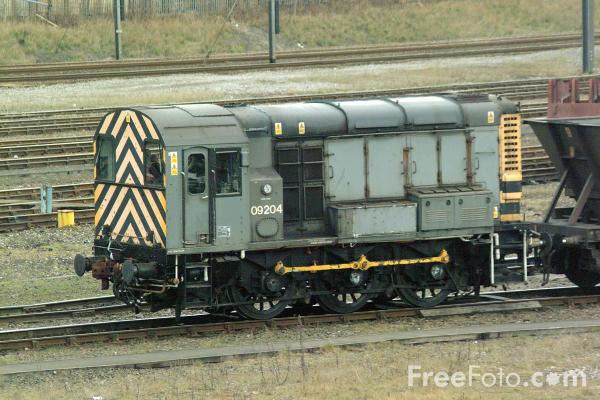 |
|
| Shunters Class 10 | Diesel | 27.5 mph | Very high | BR Darlington and Doncaster Works; Blackstone E6RT Engine: GEC Traction Motors; All withdrawn between 1967 and 1972 | https://en.wikipedia.org/wiki/British_Rail_Class_10 | |
| Shunters Class 11 | Diesel | 20 mph | Very High | LMS/BR Derby and Darlington Works; Based on an earlier batch of loco's built for the LMS; EE Engine and equipment; Withdrawn between 1967 and 1972 | https://en.wikipedia.org/wiki/British_Rail_Class_11 | |
| Shunters Class 12 | Diesel | 27.5 mph | Very High | SR/BR Ashford Works; Used mainly in Hither Green and Norwood Junction Yards; EE Engine and equipment; Withdrawn between 1968 and 1971 | https://en.wikipedia.org/wiki/British_Rail_Class_12 | |
| Shunters Class 13 | Diesel | 25 mph | Very High | Used in Tinsley Yard to shunt the hump. 2 x Class 08 permanently coupled with the driving cab removed from one (Master + Slave); But as traffic declined 13002 was withdrawn in 1983 and scrapped at Swindon Works, the remaining 2 loco's following in 1985 with the closure of Tinsley Hump. 003 scrapped at Doncaster Works and 001 at Swindon Works | 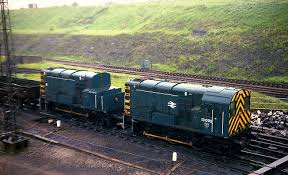 |
|
| Loco Class 14 | Diesel | 40 mph | Very High | WR Small Diesel Hydraulic 0-6-0 built at Swindon Works "Teddy Bears"; Worked mainly singly on freight and local yard duties, but by 1968 the work for which they were built had dried up and they were either sold to industry or scrapped. The NCB at Ashington had some but the biggest users were BSC at the once very large Corby Steel Works; 19 preserved | 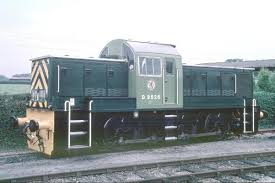 |
|
| Loco Class 15 | Diesel | 60 mph | Worked mainly singly on Freight and ECS | ER; BTH (British Thompson Houston) designed Type 1 Locomotive; Unreliability and a decline in traffic saw all withdrawn by 1971. 4 converted for use as Carriage Heating Units based at CR ,EP , FP and SF. 1 preserved | 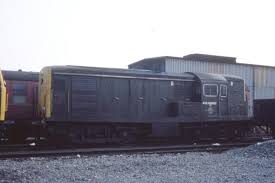 |
|
| Loco Class 16 | Diesel | 60 mph | Worked mainly singly on Freight | ER; North British Type 1 Locomotive; Like the BTH Class 15's they suffered with reliability problems with the Paxman 16YHXL engine and was made worse by poor ventilation and oil and coolant contamination resulting in frequent engine seizures. All withdrawn between February and September 1968 and all scrapped the following year |  |
|
| Loco Class 17 | Diesel | 60 mph | Worked mainly in pairs on Freight | The Claytons; ScR,MR,ER; The most unsuccessful and unreliable Type 1 diesel built, The twin Paxman 6ZHXL engines with which most were fitted proved extremely troublesome even after modification; All withdrawn by 1971; Some sold for industrial use; 1 preserved | 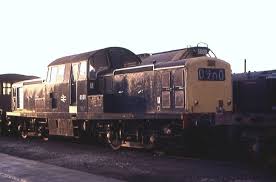 |
|
| Loco Class 18 | Diesel+Battery | 12 mph | New Clayton CBD90 Hybrid+ Shunting Locomotives being built for Beacon Rail/GBRf | https://en.wikipedia.org/wiki/British_Rail_Class_18 | ||
| Loco Class 20 | Diesel | 75 mph | Usually worked in pairs on Freight. Occasionally seen on Passenger | Allocations on MR,ER,ScR; English Electric Type 1 (The most reliable Type 1 locomotive); After the initial order was completed a further 100 loco's were built to replace the unreliable Class 17's: Main users now are HNRC and DRS; 22 preserved | 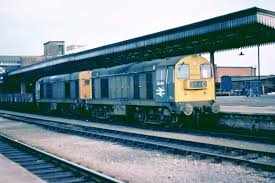 |
|
| Loco Class 21 | Diesel | 75 mph | Worked singly or in pairs on Passenger & Freight | ScR; North British Type 2 Locomotive; Unreliability saw all withdrawn by 1968 (Except those converted to Class 29 (20 locos); All in the D6100-37 range) | 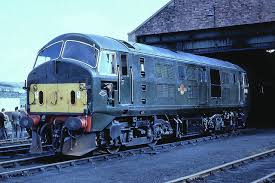 |
|
| Loco Class 22 | Diesel | 75 mph | Worked singly or in pairs on Passenger & Freight | WR; North British Type 2 Diesel Hydraulic version of Class 21; Due to NB folding and lack of spares all were withdrawn by 1971; 1 (D6319) had been bought by a private individual for preservation but was still cut up at Swindon Works by accident (D821 Greyhound was offered instead, becoming the first preserved mainline diesel locomotive in the UK) | 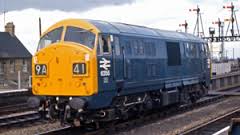 |
|
| Loco Class 23 | Diesel | 75 mph | Worked singly on Passenger and Freight | ER; English Electric Type 2 Locomotive fitted with Napier Deltic T29-9 engine; Baby Deltics; All withdrawn by 1971; One engine from the last example to be cut up preserved and in working order at Barrow Hill (In the body of 37 372); Being rebuilt (As a Class 23) and will carry the number D5910 | 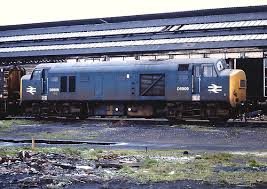 |
|
| Loco Class 24 | Diesel | 75 mph | Worked singly or in pairs on Passenger & Freight | MR,ER,ScR; (Type 2 locomotive from the 1955 modernisation scheme which was a pilot for the similar class 25); Once WCML electrification reached Glasgow the class started to be withdrawn in earnest from 1974 to 1980; 24081 was the last of the class to be withdrawn (Now preserved); 3 were taken in to departmental use (24054, 061 and 142); Most of the class were cut up at Swindon Works (Others at Doncaster and Glasgow); 4 preserved | 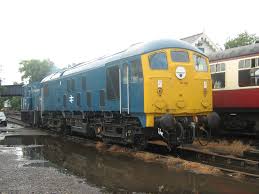 |
|
| Loco Class 25 | Diesel | 90 mph | Worked singly or in pairs on Passenger & Freight | MR,ER,ScR; BR/Beyer Peacock Type 2; Used on all regions but only allocated on the MR,ER and ScR initially, some were transferred to the WR to replace the NBL Class 22's. They could be seen just about anywhere on the network for 2 decades. Withdrawals started in 1976 with a few but by 1980 the class was gradually withdrawn until only 12 remained by 1987 which was their final year. 3 were converted as Train heating units (ETHEL 1-3) in 1983 but only lasted until 1990 before they too were gone. 20 preserved | 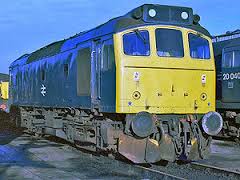 |
|
| Loco Class 26 | Diesel | 80 mph | Worked mainly singly on Passenger & Freight | Scottish Region; BRCW Type 2; Spent most of their lives in Scotland although they did make regular visits across the border at Carlisle and Preston in particular. Once Ravenscraig Steel Works was closed in 1991 the ScR was facing a surplus of loco's and the class had already begun to be withdrawn in 1990. The remaining loco's were all withdrawn in October 1993; 13 preserved | 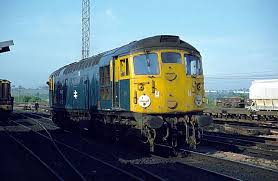 |
|
| Loco Class 27 | Diesel | 90 mph | Worked mainly singly on Passenger & Freight | Scottish Region; BRCW Type 2; All allocated to the ScR by 1969, they were regular traction on the West Highland line for many years. When the Swindon Intercity DMU's used on Glasgow - Edinburgh services started to become unreliable 2 sub classes were formed - 27/1 and 27/2 (ETH fitted) for use with rakes of Mk 2 coaches in push/pull mode with a loco of each sub class at each end and used from 1973. But the diagrams were demanding and resulted in poor availability. Their duties on these services were taken over by Class 47/7's with Mk 3 coaches and a DBSO in 1980 and the 2 sub classes reverted to 27/0. In 1984 the class was gradually withdrawn until the last examples were taken out of traffic in 1987; 8 preserved | 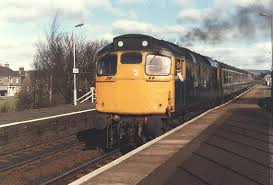 |
|
| Loco Class 28 | Diesel | 75 mph | Worked singly or in pairs on Passenger and Freight | MR; Metropolitan Vickers Type 2 Locomotive fitted with Crossley engine which proved to be troublesome from introduction: so much so that they were all returned to MV for rectification work in 1961; Unusual Wheel arrangement Co-Bo; All withdrawn between 1967 and 1968; 1 preserved | 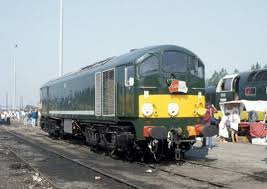 |
|
| Loco Class 29 | Diesel | 80 mph | Worked mainly singly on Passenger & Freight | ScR; Re-engined Class 21 with Paxman Ventura (Vice licence built MAN); All withdrawn by 1971 after being deemed non standard; none preserved | 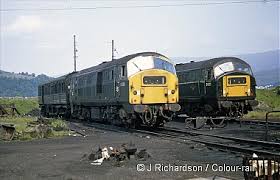 |
|
| Loco Class 31 | Diesel | 80/90 mph | Worked singly or in pairs on Passenger and Freight. 31/0 80 mph | Built with Mirrlees engines but entire class re-equipped with English Electric 12SVT power units (From Class 37 but de-rated to 1,470 hp). Some fitted with ETH - 31/4; Brush Type 2; Not many now in use with only DCR and NR owning working mainline examples;Class 31/0 retained Red Circle Electro Magnetic MW equipment and were the first of the class to go being deemed non standard; 26 preserved | 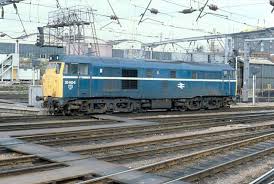 |
|
| Loco Class 33 | Diesel | 85 mph | Worked singly or in pairs on Passenger and Freight. Southern Region | ETH fitted. 33/1 Push/Pull fitted; 33/2 built to Hastings loading gauge "Slim Jims"; BRCW Type 3; Only 3 now in use with WCRC; 29 preserved | 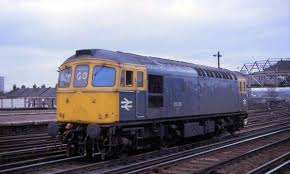 |
|
| Loco Class 35 | Diesel | 90 mph | Worked mainly singly on Passenger and Freight | The Hymeks (WR Diesel Hydraulic workhorses built by Beyer Peacock until all were withdrawn between 1971 and 1975); Bristol Siddeley Maybach MD870 engine; 4 preserved; Type 3 | 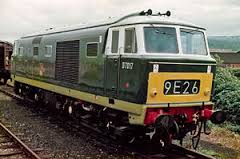 |
|
| Loco Class 37 | Diesel | 90 mph | Worked singly or in pairs mainly on Freight but also some Passenger | Some fitted with ETH - 37/4; A number of locomotives were rebuilt in the late 80's to evaluate Mirrlees and Ruston power units for the proposed Class 38 freight loco but this design never went in to production - 37/9; Others rebuilt for heavy freight workings 37/5/7/8 and Channel Tunnel sleeper services 37/6 but this never happened and they were sold to private operators; English Electric Type 3; Main users now are Colas, DRS, WCRC and NR; 48 preserved | 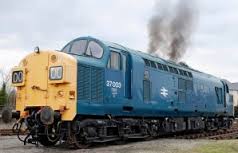 |
|
| Loco Class 40 | Diesel | 90 mph | Worked mainly singly on Passenger and Freight | MR,ER,ScR; English Electric Type 4 "Whistlers"; Withdrawals started in 1976 but by the early 80's the class was disappearing rapidly until all were gone from regular service by 1985. 7 preserved | 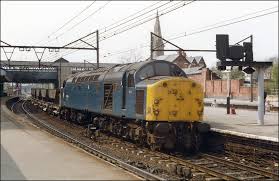 |
|
| Loco Class 41 | Diesel | 90 mph | Worked singly on Passenger & Freight | The Warships - D600 - D604 (WR Diesel Hydraulics built by North British. All withdrawn by the end of 1967; NBL/MAN L12V 18/21S engines) none preserved; Practically obsolete from the day they came off the drawing board, they were heavy and did not have a good power to weight ratio; Like the rest of the Hydraulic classes they were deemed non standard and were the first to be withdrawn, despite the first 2 having engines and mechanical parts made in Germany which were reliable |  |
|
| Loco Class 42 | Diesel | 90 mph | Worked mainly singly on Passenger and Freight | The Warships - D800 - D832 and D866-70 (WR Diesel Hydraulics built at Swindon Works. All withdrawn by the end of 1972; Bristol Siddeley Maybach MD 650 engines) 2 preserved; Lack of space to install air brake equipment or ETH really shortened the lives of both (D800) Warship classes and they were gradually withdrawn from 1968 onwards until the mass withdrawals of 1971. Withdrawn examples being canibalised to keep others going until they were all gone | 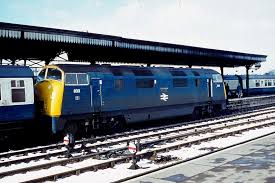 |
|
| Loco Class 43 | Diesel | 90 mph | Worked mainly singly on Passenger and Freight | The Warships - D833 - D865 (WR Diesel Hydraulics built by North British. All withdrawn by the end of 1971; MAN L12V 18/21 engines) none preserved | 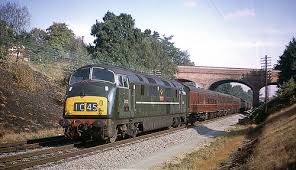 |
|
| Loco Class 44 | Diesel | 75 mph | Worked mainly singly on Freight | The original batch of 10 "Peaks" all named after British Mountains (Classes 45/46 also called Peaks being almost identical in design); Synonymous with Toton depot all were withdrawn by November 1979. 2 Preserved | 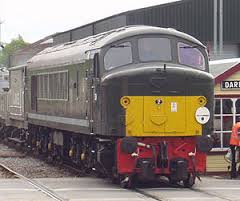 |
|
| Loco Class 45 | Diesel | 90 mph | Worked mainly singly on Passenger and Freight | MR,ER and seen on the WR particularly XC services; Mainstays on the MML until HST's were introduced on the route; Crompton Parkinson Equipment; Gradually withdrawn from 1981 - 1988, the last example was withdrawn in 1989, their last major stronghold being on the Transpennine routes; 12 preserved | 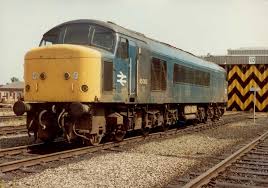 |
|
| Loco Class 46 | Diesel | 90 mph | Worked mainly singly on Passenger and Freight | MR,ER,WR; Brush Equipment; All withdrawn by 1984; Regulars on the Cross Country routes, semi fast Newcastle - Kings Cross services and the Clay hood trains between Cornwall and the Stoke on Trent area. 3 preserved; Allocated mainly at GD but the WR also had small allocations at BR and LA | 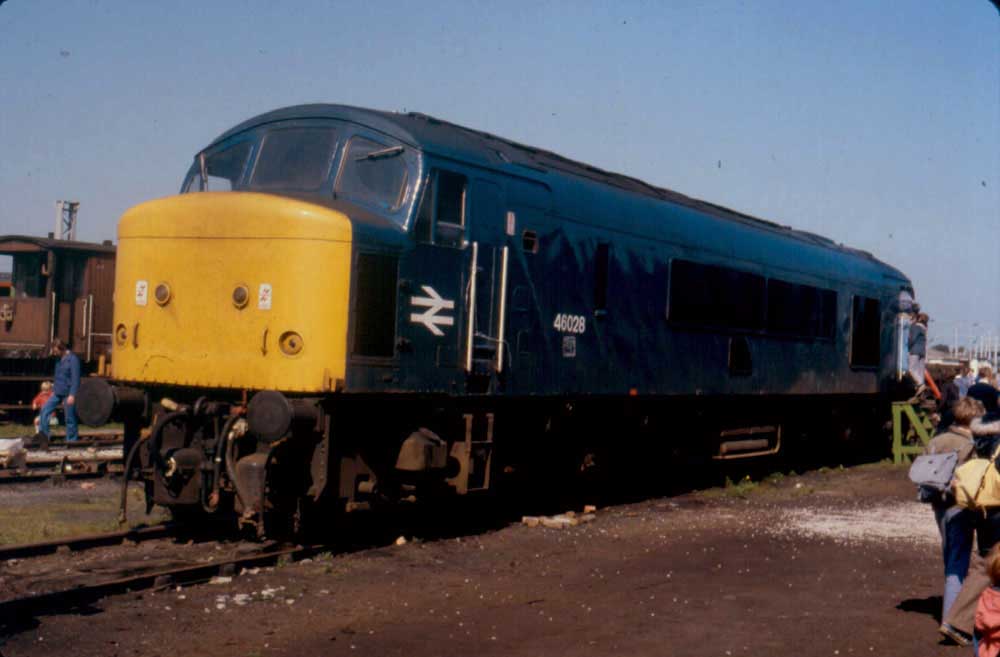 |
|
| Loco Class 47 | Diesel | 95 mph | Worked mainly singly on Passenger and Freight | Ubiquitous to all regions; Brush Type 4; One locomotive (47046) fitted with a 16-cylinder Ruston 16RK3CT engine rated at 3,250 bhp for use as a test bed in the Class 56 program and renumbered 47601 and later with a Ruston Paxman 12RK3ACT of 3,300 bhp for use in the Class 58 program and renumbered 47901; Currently 30 registered for mainline use with Colas, DRS, Freightliner, Nemesis Rail, Riviera Trains and WCRC; Many stored in serviceable and unserviceable condition; 32 preserved | 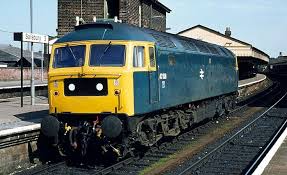 |
|
| Loco Class 50 | Diesel | 100 mph | Worked mainly singly on Passenger | Started life on the MR but best remembered on the WR; Given names from former Class 42/43 Warship Class; English Electric Type 4; Once electrification of the WCML reached Glasgow in 1974 the entire class was transferred to the WR by 1976 and used on top express work (alongside Class 47's) which the now dwindling numbers of Class 52's had vacated. Once more HST's became available they were used on commuter services to Oxford, Banbury, Newbury and Westbury; Their final fling was the Southwestern mainline between Waterloo and Exeter but with no more major overhauls planned the last members of the class were withdrawn in 1994; 18 preserved; Replaced by Class 47/7, latterly Class 159 | 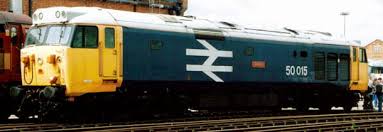 |
|
| Loco Class 52 | Diesel | 90 mph | Worked mainly singly on Passenger and Freight | The Westerns (Built at Swindon and Crewe Works; Most powerful of the WR Diesel Hydraulics and fondly remembered (Bristol Siddeley Maybach MD655 engines); After withdrawal (Between 1973 and 1977) Most were scrapped at Swindon Works except those preserved) 7 preserved; Lack of ETH and the introduction of the HST sealed their fate | 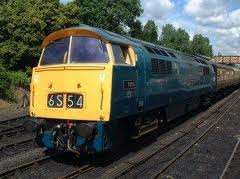 |
|
| Loco Class 55 | Diesel | 100 mph | Worked mainly singly on Passenger | ECML The Deltics !!; Allocated to FP, HA and GD; All withdrawn by early 1982 and apart from those preserved were all scrapped at Doncaster Works; High maintenance costs and the introduction of HST's on the ER was the end of the line for these iconic machines; One final fling on transpennine services in their last year of service saw all allocated to YK where they were all withdrawn between January 1981 and January 1982; 7 preserved; English Electric Type 5 | 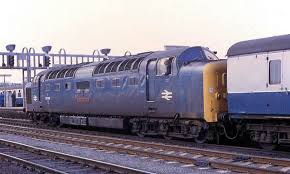 |
|
| Loco Class 56 | Diesel | 80 mph | Worked mainly singly on Freight | Mostly associated with MGR workings on MR,ER,ScR; First 30 loco's built in Romania by Electroputere but completely rebuilt after delivery; Nearly all withdrawn by EWS but some still in use with Floyd ZRt in Hungary, Colas and DCR; Others now owned by British American Railway Services and UK Rail Leasing and hired on an "As required" basis from Leicester and Burton depots; 16 purchased by GBRf for conversion to Class 69; 5 preserved | 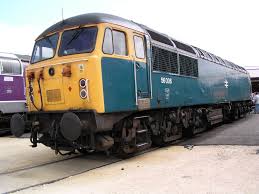 |
|
| Loco Class 57 | Diesel | 75/95 mph | Worked singly on Freightliner trains 57/0 (75 mph) also on Passenger for Virgin (Thunderbird) 57/3 & FGW (Sleeper services) 57/6 (95 mph) | Rebuilt Class 47 with refurbished GM Engine and Alternator; 57601 built as a prototype and used by FGW initially now WCRC; All Freightliner 57/0's and some Virgin 57/3's now sold to private operators |  |
|
| Loco Class 58 | Diesel | 80 mph | Worked mainly singly on Freight | Mostly associated with MGR workings to and from MR,ER; All withdrawn. Some used on various European High Speed line projects in France and Spain; The only active examples are in France (ETF/TSO) and Spain (Transfesa); 1 preserved (1 used as a donor loco for spares) | 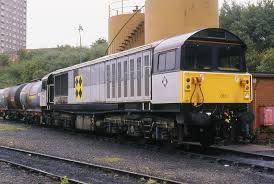 |
|
| Loco Class 59 | Diesel | 60 mph | Worked exclusively on Stone Trains to and from the WR 59/0 & 59/1 | 59/2 built for Coal Workings from Ferrybridge P S (National Power); Based on the very successful SD40-2 with which they share many features and built by GM/EMD at their LaGrange plant, Illinois, US; EMD 645 series engine; 59003 brought back from Europe and transferred to GBRF; 59/0, 59/1 & 59/2 all now owned by Freightliner but maintained by Mendip Rail; 59/0 and 59/1 now transferred to Freightliner Heavy Haul after award of Mendip Stone contract | 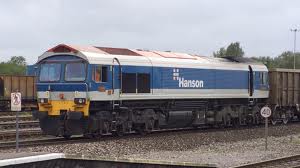 |
|
| Loco Class 60 | Diesel | 60 mph | Worked mainly singly on Freight particularly Bogie Tanks and Bulk Minerals | Ubiquitous to all regions. Many now stored at Toton out of use with some being scrapped. A few purchased by GBRf, Colas and DCR | 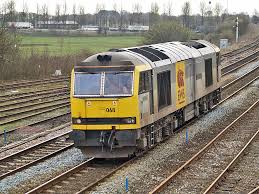 |
|
| Loco Class 66 | Diesel | 65/75 mph | Worked mainly singly on Freight. 66/6 (FHH) 65 mph Max Speed | Utilising the same body shell as the Class 59 but using the EMD 710 series engine with equipment similar to the SD70-MAC; Built by EMD at their London, Ontario plant in Canada; Now used by DBS, Freightliner. GBRF, DRS and Colas; DBS and Freightliner have sent some to Europe for use with subsidiary companies; GBRf have now signed a 10 year lease agreement with French leasing company Akiem to acquire 11 Class 66 and 77 locomotives from Europe to be used in the UK. All numbered in the 66/3 series once modified for UK use | 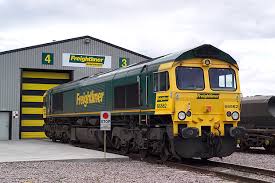 |
|
| Loco Class 67 | Diesel | 100 mph | Originally built for TPO workings | Now used for various charters and spot hire and the Royal Train. Some used for dedicated Passenger work and were used on the Caledonian Sleepers North of Edinburgh and Glasgow (Now 73/9); 2 recently purchased by Colas | 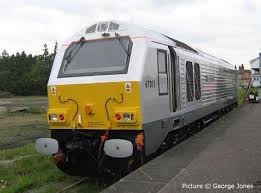 |
|
| Loco Class 68 | Diesel | 100 mph | Mixed traffic locos, built for DRS. 6 locos used by Chiltern for their "Mainline" services. FTPE will also use a batch on some services with Mk 5A stock | Built by Vossloh (Now Stadler), adapted from their 'Eurolight' design. A further 17 loco's have now been delivered to DRS. TPE have now reintroduced loco and coaches to some services using Class 68's (Leased from DRS and new Mk 5A stock bult in Spain by CAF). Network Rail have approved DRS Class 68s to run light engine as one or in two loco formation or mixed 68/88 formation at 100mph or to the maximum line speed permitted. | 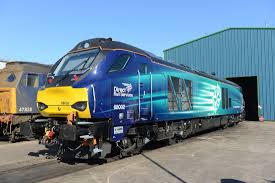 |
|
| Loco Class 69 | Diesel | 80 mph | GBRf Class 56 conversions | Class 56 fitted with EMD 710 series engine and electronic equipment the same as class 66; Due for delivery 2021 from Progress Rail at Longport; 69001 recently on test at the SVR; Initial 10 ordered with an option for 6 more | https://en.wikipedia.org/wiki/British_Rail_Class_69 | |
| Loco Class 70 | Diesel | 75 mph | Freightliner and Colas 4000 hp locos | Built by GE in the US. Freightliner have now run a successful trial on the Mendip Rail Jumbo Stone train with a single Class 70 hauling 4624 tons | 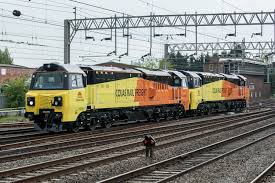 |
|
| Loco Class 71 | 3rd Rail + pantograph for use in some yards | 90 mph | Worked mainly singly on Passenger and Freight | SR Electric loco's; Most fitted with a pantograph for use in certain yards (Hither Green, Snowdown Colliery) so that staff didn't risk electrocution from the third rail with tram style OHLE used; (All withdrawn in 1977) 1 preserved | 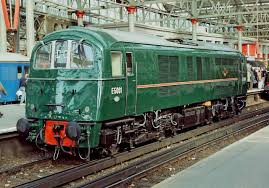 |
|
| Loco Class 73 | Diesel + 3rd Rail | 80/90 mph | Worked singly or in pairs on Passenger and Freight. Southern Region | 73/0 80 mph 73/1 & 73/2 90 mph (Dedicated pool of Class 73/2 loco's used on Gatwick Express services until replaced by Clas 460. Some now used as Thunderbird loco's, others in use with private operators or NR); 13 loco's now partially rebuilt (or in the process of) with new engines and electrical systems; 73 951 and 952 using 2 x Cummins QSK 19 engines of 750 hp for a total of 1,500 hp for NR; GBRF are also converting 11 loco's with MTU 8V 4000 R43L 1,600 hp V8 engines (Vice original EE 4SRKT Mk II; 73/9) and some are now leased to SERCO for use on the Caledonian Sleepers North of Edinburgh and Glasgow | 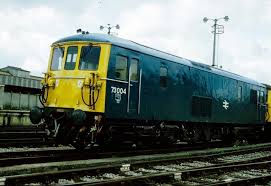 |
|
| Loco Class 74 | Diesel + 3rd Rail | 90 mph | Worked mainly singly on Passenger and Freight | Conversion of 10 Class 71 loco's to ED by fitting a Paxman Ventura Engine "Big ED's" (Unreliability saw all withdrawn by the end of 1977) | 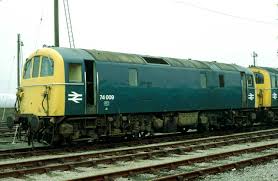 |
|
| Loco Class 76 | 1500v DC | 75 mph | Worked singly and in pairs on Freight | Class EM1 Loco's built for the Woodhead Route (Extremely reliable machines) All withdrawn when most of the line closed in 1981. 1 Preserved | 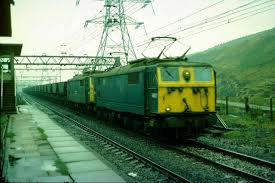 |
|
| Loco Class 77 | 1500v DC | 90 mph | Worked singly on Passenger | Class EM2 Loco's built for the Woodhead Route; All sold to Netherlands Railways in 1969 where they served until 1986. 3 preserved 1 used as a source of spares | 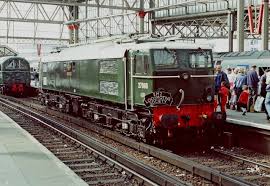 |
|
| Loco Class 81 | 25KV AC | 100 mph | Worked mainly singly on Passenger and Freight | Early WCML locos "Roarers"; Built by AEI (Associated Electrical Industries) Amalgamation of Metropolitan Vickers and British Thompson Houston; Allocated to GW or WN; All withdrawn by 1991, the final few being used on ECS workings between Willesden CS and London Euston; 1 preserved | 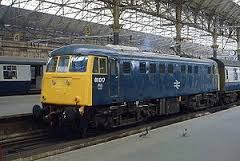 |
|
| Loco Class 82 | 25KV AC | 100 mph | Worked mainly singly on Passenger and Freight | Early WCML locos "Roarers"; Built by Beyer Peacock; Allocated to LG or WN; All stored in 1982 and most withdrawn in 1983 except 2 (82005 and 82008) which were used for ECS workings between Willesden CS and London Euston until 1987; 1 preserved | 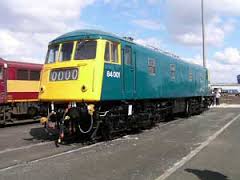 |
|
| Loco Class 83 | 25KV AC | 100 mph | Worked mainly singly on Passenger and Freight | Early WCML locos "Roarers";Built by English Electric.; Allocated to LG or WN; Most were withdrawn in 1983 except 3 (83009, 83012 and 83015) which were used on ECS workings between Willesden CS and London Euston until 1989; 1 preserved | 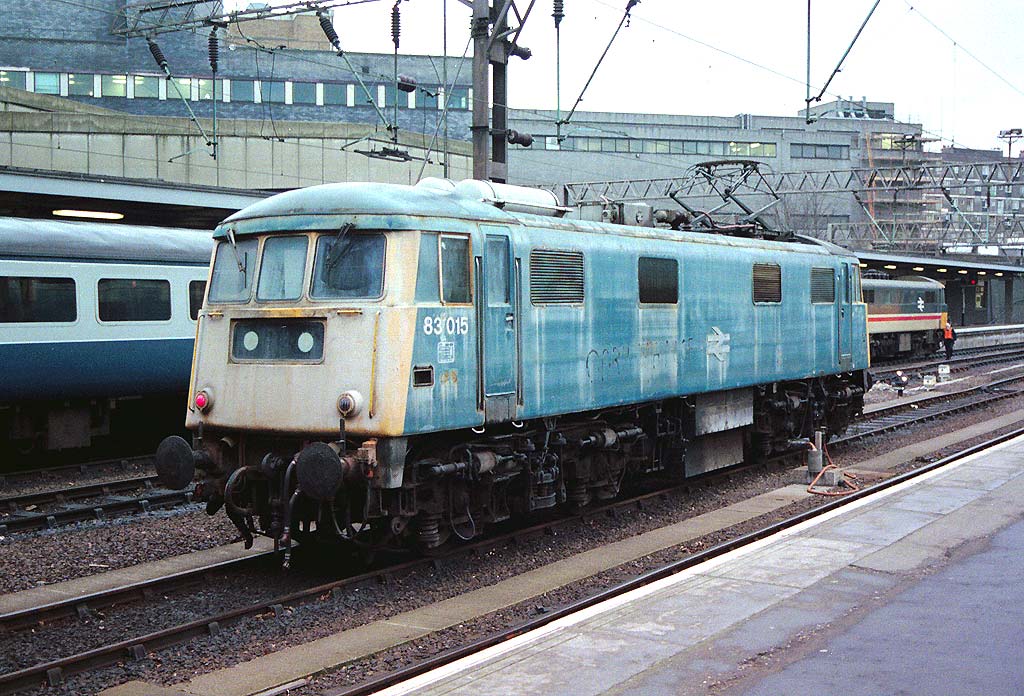 |
|
| Loco Class 84 | 25KV AC | 100 mph | Worked mainly singly on Passenger and Freight | Early WCML locos "Roarers";Built by North British. They suffered with problems with their Mercury Arc Rectifiers and were stored in the early 70's for a period but once the WCML was electrified to Glasgow they were put back in to service; Allocated to LG. Withdrawn between 1977 and 1980; 1 used as a Mobile Load Test Bank at RTC Derby (84009/ RTC number ADB968021); 1 preserved. | 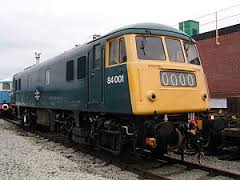 |
|
| Loco Class 85 | 25KV AC | 100 mph | Worked mainly singly on Passenger and Freight | Early WCML locos "Roarers";Built at Doncaster Works; Allocated to CE; 14 later converted to 85/1 for use on freight but all withdrawn by 1991; 1 preserved | 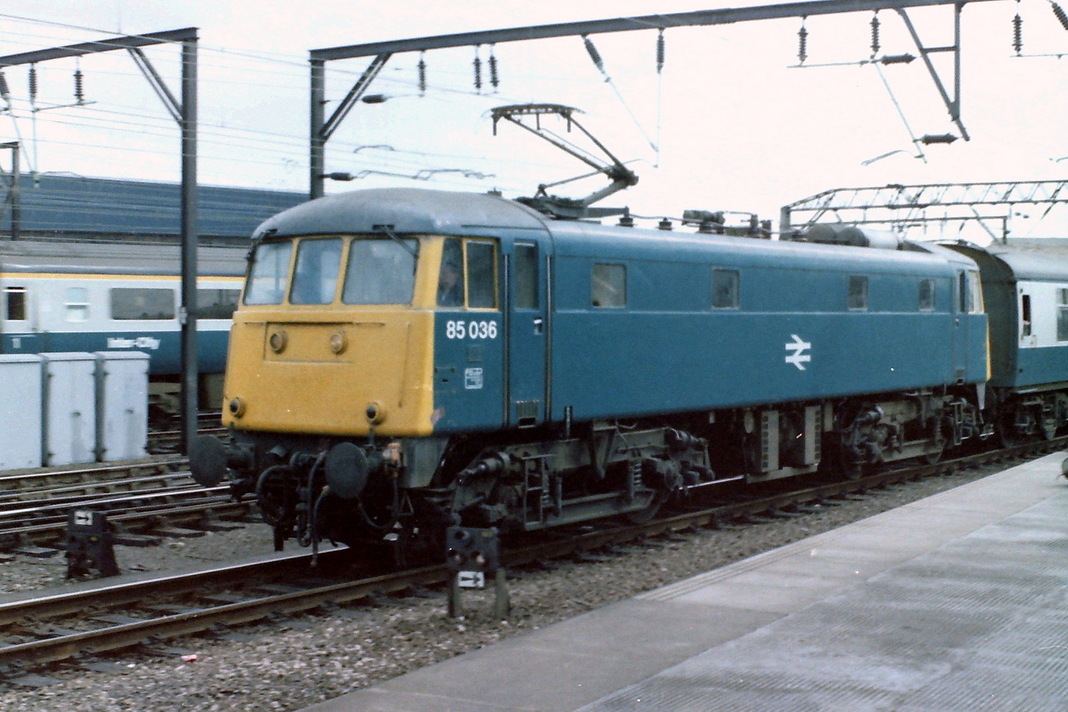 |
|
| Loco Class 86 | 25KV AC | 100/110 mph | Worked singly on Passenger, sometimes in pairs on Freightliner workings | Later fitted for Push/Pull working with DVT. Later WCML locos; Allocated to WN; The only major UK user of the class was Freightliner but sold their remaining 16 loco's in March 2021 to Express Services, Bulgaria (Class 86/6). Some were bought by Hungarian private freight company Floyd ZRt and one is used as a source of spares. 4 preserved but two of these are used to bring the empty stock for the Caledonian Sleepers in to London Euston (86101 and 86401) | 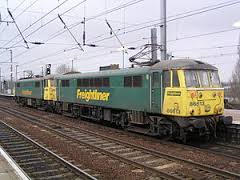 |
|
| Loco Class 87 | 25KV AC | 100/110 mph | Worked singly on Passenger, sometimes in pairs on Freightliner workings | Later fitted for Push/Pull working with DVT. Later WCML locos; Allocated to WN; After the class finished on the WCML with Virgin Trains (Post Pendolino introduction), many were shipped to Bulgaria and used by private company "Bulmarket" with whom they are still in use. Only 3 remain in the UK - 87001 preserved at the NRM in York; 87002 which has recently been hired to SERCO for use on the Caledonian Sleepers; and 87035 which is preserved at Crewe Heritage Centre | 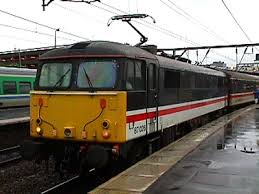 |
|
| Loco Class 88 | 25 KV AC + Diesel | 100 mph | New Vossloh (Now Stadler) UK Dual locomotives being built for DRS (10 ordered) | All now delivered and in service. Class 88s are mainly found on the Sellafield Flask workings or the daily Tesco/Stobart intermodal service between Daventry & Mossend. Network Rail have approved DRS Class 88s to run light engine as one or in two loco formation or mixed 68/88 formation at 100mph or to the maximum line speed permitted. | https://en.wikipedia.org/wiki/British_Rail_Class_88 | |
| Loco Class 89 | 25KV AC | 125 mph | One off Brush built loco for ECML Electrification. Passenger Only | Fitted for Push/Pull working with DVT; Built at BREL Crewe in 1986 and tested on both the ECML and WCML It was then stored out of use for a time, but when GNER were suffering a shortage of available Class 91's, 89001 was purchased and put back in to service in March 1997 after an overhaul to work some Leeds/Bradford services. But a major failure in 2001 saw the locomotive laid up again and it was eventually put up for tender and sold to the Electric Traction Group for preservation and housed at Barrow Hill. Currently under test after restoration and repainting in to Intercity Swallow livery at Soho EMUD; Many features used on Eurotunnel Class 9 Shuttle loco's and Class 92 | 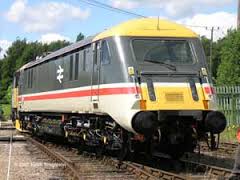 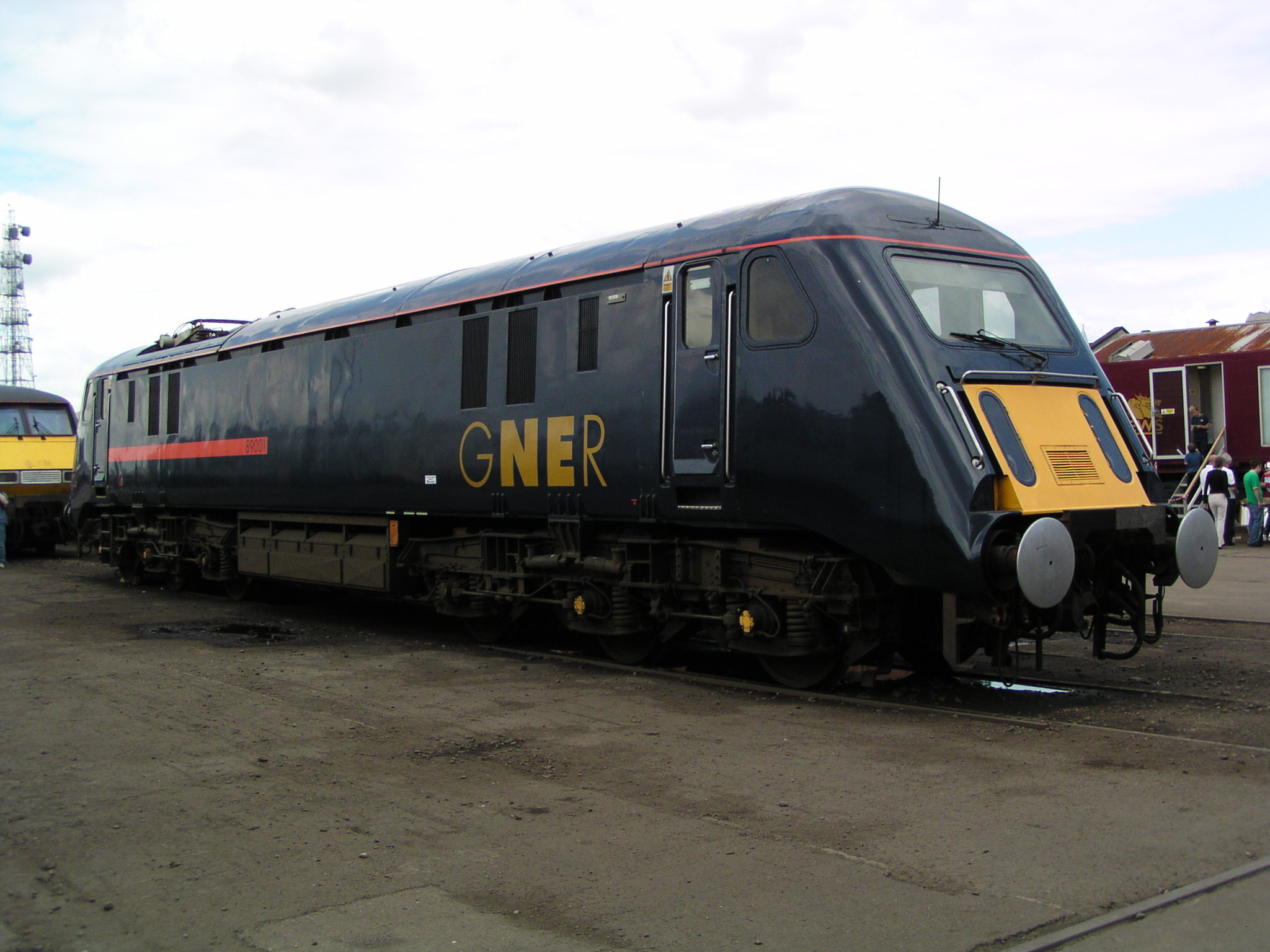 ; In GNER Livery ; In GNER Livery |
|
| Loco Class 90 | 25KV AC | 110 mph | Worked singly on Passenger and occasionally in pairs on Freightliner workings | Fitted for Push/Pull working with DVT. WCML, ECML and East Anglia. Also Caledonian Sleepers to Glasgow/Edinburgh; Now replaced by the new Stadler Class 745 FLIRT EMU's on Greater Anglia which entered service on 8th January 2020; The only major UK user is now Freightliner with others privately owned | 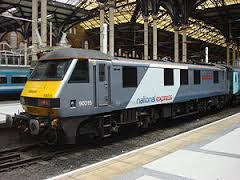 |
|
| Loco Class 91 | 25KV AC | 125 mph | Worked exclusively on ECML Passenger services | Derived from the failed APT-P with many components and features incorporated; Fitted for Push/Pull working with DVT and Mk IV stock; allocated to BN; Will be replaced partly by the new Hitachi IEP trains; The remaining 12 locomotives and 8 Mk IV sets will be replaced by new CAF 10 car tri mode units; First 2 to be taken off lease were 91103 and 91108 as IEP's entered service; 91117 and 91120 were purchased by Europhoenix for use in Europe | 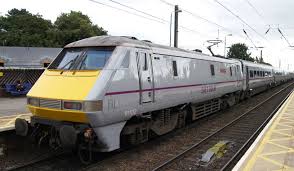 |
|
| Loco Class 92 | 3rd Rail+25KV AC | 90 mph | Originally built for Channel Tunnel Freight services | Now used on WCML & ECML Freight and some Channel Tunnel Freight services; also now used on the Caledonian Sleepers; Some sold to Eurotunnel and Private Operators | 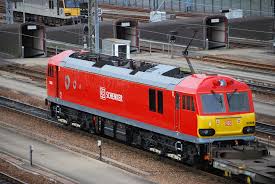 |
|
| Loco Class 93 | 25KV AC+Diesel+Battery | 110 mph | New Stadler Euro Dual locomotives being developed and built for Rail Operations Group | Further development of the Class 88 built for DRS but will be tri mode and have Lithium Titanate oxide batteries allowing for use on electrified and non electrified routes; 30 ordered; Deliveries started in late 2023 | https://en.wikipedia.org/wiki/British_Rail_Class_93_(Stadler) | |
| Loco Class 99 | 25KV AC+Diesel | 75 mph | New Beacon Rail/Stadler Euro Dual locomotives being developed and built for GBRf | 8050 hp Co-Co dual mode locomotives which will replace some Class 66's; 30 ordered; Deliveries expected to start in 2025 | https://en.wikipedia.org/wiki/British_Rail_Class_99_(locomotive) |
Locomotive Multiple Working
| Code | System | Loco class(s) | |
|---|---|---|---|
| Blue Star |
Electro-pneumatic | Class 15, Class 17 (Nos D8588–D8616), Class 20, Class 21 (Nos D6138-D6157), Class 24, Class 25, Class 26, Class 27, Classes 31/1 & 4, Class 33, Class 37, Class 40, Class 44, Class 45 and Class 46, Class 73 (under diesel power only) |
|
| Red Circle |
Electro-magnetic | Class 16, Class 21 (Nos D6100-D6137), Class 28, Class 29, Class 31/0 | |
| Green Circle |
Some Class 47 | ||
| Orange Square |
Class 50 | ||
| Red Diamond |
Class D16/1 (nos 10000/10001), Class 17 (D8500–D8587), Class 56, Class 58 | ||
| White Diamond |
Diesel Hydraulics | Class 22, Class 41, Class 42, Class 43 | |
| Yellow Triangle |
Diesel Hydraulics | Class 35 | |
| SR EMU System | Class 33/1, Class 73, Mark I Electric Multiple Units | ||
| AC Electric Locomotives | Class 87, some Class 86s. | ||
| Within own class only | Class 43 (InterCity 125),Class 60, Class 68, Class 88 (NR have allowed 100 mph or line speed LE movements of Class 68/88 coupled in multiple), Class 92 (Electrical Train Bus System) | ||
| TDM (Time Division Mutliplex) System | Class 86, Class 87, Class 89, Class 90, Class 91, DBSO, DVT. | ||
| AAR (Association of American Railroads) System | Class 59, Class 66, Class 67 & Class 70, plus several converted DVTs |
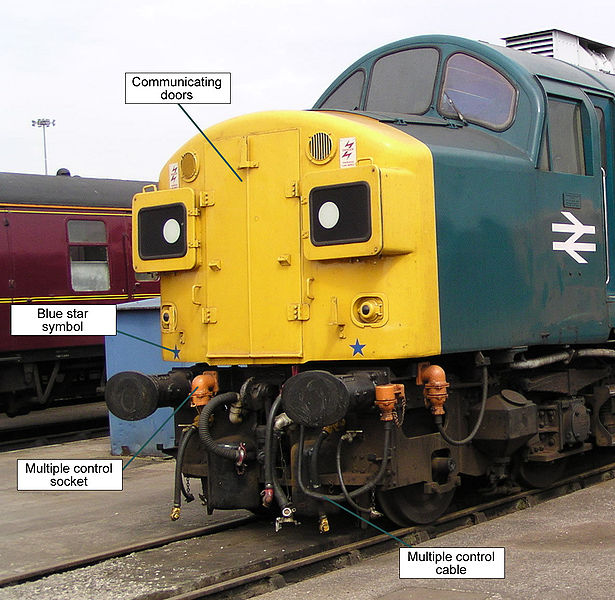
Picture showing the cable and socket on 40 135 for the Blue Star multiple working system. The socket on the left is for the cable from the other locomotive,
the cable on the right would connect to the other locomotive thus completing the circuit for full multiple working (Along with Control Air Pipes for most loco's).
=
Notes
- Early Diesel Locomotive classes could be notoriously difficult to work in multiple due to the number of manufacturers and the different systems each one used (Usually requiring a driver in each loco).
- As time progressed however the "Coloured Symbol" system was introduced (Displayed on each end of the loco) allowing loco's from different classes but within the same "Code" to work together in multiple with a single driver. Some manufacturers using the eventual Blue Star electro-pneumatic MW system and others the Red Circle electro-magnetic MW system for example.
- Modern day practice does not see quite so much multiple working but allows for more Push/Pull type operations with the TDM or AAR systems.
- Older Locomotives such as the Class 20's and 37's owned by DRS for example could be seen working in multiple on Nuclear Flask Trains.
- BR Policies had changed by the late 1960's. The National Traction Plan of 1967/68 decreed that all classes of locomotive should be Diesel Electrics, with the number of classes reduced to 15 from 28 by 1974. This spelt the end for the Western Region's Diesel Hydraulic classes which were now considered non standard. Only the Westerns soldiered on until early 1977. The rest had started to be withdrawn as early as 1967 with the majority all gone by 1975.
- The more unreliable and expensive to maintain types (Mostly built by North British and Clayton or BTH) were also pruned and had all gone by the end of 1972. This left a few reliable Diesel Electric classes but even then there were to be more cuts to services with the ever increasing loss of freight traffic to road vehicles; thus seeing a decrease in demand for use in locomotives.
- By the late 1970's both diesel and electric traction were under threat with Classes 24, 40, 44 and 84 the first to start a long line of withdrawals that lasted until the mid 90's prior to the privatised railway. With investment down and a shrinking market share the aging fleet of mainly 1950's and 60's built loco's diminished drastically throughout the early and mid 80's with many well known classes facing the scrapman's torch although many were saved for preservation.
- The big BR works also started to feel this pinch with famous locations like Swindon closing in 1987. Even the mighty Crewe works has now been consigned to the history books with only Derby Litchurch Lane remaining as the sole major workshops still building new rolling stock in the UK.
- With the advent of privatisation came new thinking. Ed Berkhardt's purchase of Mainline, Loadhaul and Transrail freight companies and re-branding to EWS (English, Welsh and Scottish Railway. Now DB Schenker) saw purchases of new locomotives from US giant EMD at their London, Ontario plant in Canada. The first of these was the Class 66 which in reliability terms were streets ahead of anything previously built in Britain. Next were the Class 67's built in Spain, used on Postal services. In the passenger market Virgin ordered Class 220 and 221 Voyagers from Bombardier (Now Alstom) of Canada for the Cross Country franchise (Now Arriva) and for the WCML (Now Avanti West Coast) Italian designed tilting Pendolinos. Various companies have now bought the Class 66 design such is its versatility, however with the production line now closed some companies are looking at rebuilding older designs with new equipment ie GBRf Class 69.
- Britain however still got a look in with many new DMU and EMU designs coming from Bombardier (Now Alstom) at Derby based on the successful Turbostar and Electrostar designs. Siemens in Germany have won big orders with SWT (Now South Western Railway) replacing all the old slam door stock with the Desiro which has proven to be a very reliable and popular unit and 25Kv AC versions have also been built for various operators as well as the diesel Class 185 for TPE.
- In to the future we will now see overseas manufacturers like Hitachi of Japan, CAF in Spain and Swiss manufacturer Stadler, designing and building the new IEP trains which have replaced the venerable and arguably best design from BR, the HST and Class 91 and Mk IV stock. With others like Siemens still able to produce good quality trains in short periods of time. Bombardier (Now Alstom) however will still have a shout with the recent award of new trains now built and delivered for Cross Rail (Elizabeth Line) and Greater Anglia, C2C, London Midland and South Western Railway and also new LUL stock some of which has already been delivered. Stadler have now won orders for Greater Anglia, Merseyrail, Tyne and Wear Metro, Transport for Wales, Rail Operations Group and GBRf.
Last edited by moonraker on 16/11/2024 at 20:07